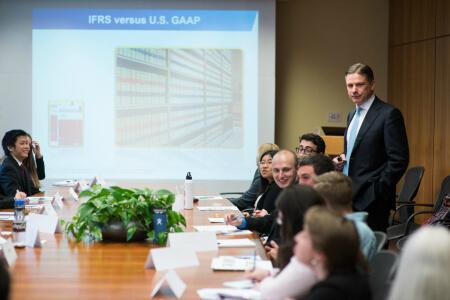On Thursday, April 7, Holger Erchinger, an Audit Partner at KPMG NYC, shared his knowledge on the current and future prospects of convergence and the challenges the accounting profession faces. Mr. Erchinger has over 20 years of professional experience in Germany and U.S. He is a CPA in both countries, and is responsible for helping clients in the areas of audit, audit-related and consulting services.
Erchinger flew in directly from New York City to discuss these issues with Professor Susan Hughes’ Master of Accountancy Capstone class. Not missing a beat, he quickly commanded the room, pacing attentively and directly seeking answers from the eager students around the table. Establishing a set of globally accepted accounting standards is a challenge to say the least. The possibilities of convergence between International Financial Reporting Standards (IFRS) and U.S. generally accepted accounting standards (GAAP) have been widely debated for years. Many obstacles will continue to restrict these possibilities, including but not limited to international politics. Erchinger questioned student knowledge of the two accounting standards, and set out by distinguishing the similarities and differences between them. With the help of a visual aid, he contrasted the length and breadth of the two standards; IFRS contains approximately 2,600 pages of material while U.S. GAAP embodies well over 35,000 pages of literature.
Erchinger emphasized the process of alignment that convergence signifies, specifically amongst principles, concepts and rules. The latter is where we need to focus our efforts if we want convergence to be possible. However, the United States, China and Japan represent the largest share of GDP on an international level, yet none of them are using IFRS. Erchinger seems to shy away from the likelihood of convergence, noting that only three of the thirty-five topics have been substantially converged thus far.
From there Erchinger propelled his energy into the concept of fair value measurement, questioning the students’ knowledge of the literature and how they have applied it throughout their education. Inquiries about calculating the appropriate discount rate surfaced multiple times, Erchinger clarified these concerns and specified the definition of an asset-specific discount rate. He continued to pinpoint several key differences within IFRS in practice, notably impairment and property, plant and equipment. Students had several chances to voice their own concerns and questions, which Erchinger enthusiastically awaited.
Erchinger closed with a look at the accounting scandals that marked the early 2000s and the Sarbanes-Oxley legislation that subsequently emerged. He noted the vast changes this created for public accounting and the enhanced role of the auditor. Overall, he was able to pack a great deal of information into a shorten time frame, and his presentation was enjoyed and appreciated throughout the conference room. Erchinger fully captured the key difficulties involved in convergence while also highlighting his own direct experience in practice. His analysis was both thorough and stimulating, and left the audience with answers and lingering questions about the culture surrounding a global set of accounting standards.
The presentation was followed by an ice cream reception held in the Fleming Museum Marble Court sponsored by the KPMG Burlington Office. Students had an opportunity to speak with Mr. Erchinger and other KPMG personnel. The students described the afternoon as “intense and informative,” “unparalleled”, and “much appreciated.”
